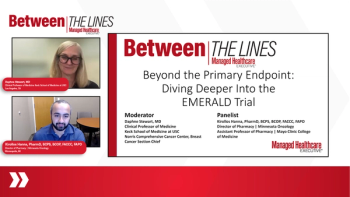
Reimbursement Challenges Associated With PDTs
Key opinion leaders provide insights regarding reimbursement challenges associated with the implementation of prescription digital therapeutics.
Episodes in this series

Megan Coder, Pharm.D., M.B.A.: Paul, let’s bring in another perspective. From your side, some of the challenges related to reimbursement are [related to] the fact that there aren’t full reimbursement benefit categories for digital therapeutics at this point. With Medicaid, it’s encouraging to hear about the work you’ve done and the leadership you’ve taken on in this space. But I’m interested to hear a little more about how you’ve worked to resolve some of those challenges, given that you’re an early adopter in your own right.
Paul L. Jeffrey, Pharm.D.: That’s a threshold question, Megan. There are efforts made to overcome some of those obstacles. I’m sure you’re aware of them. We have a new therapeutic option that’s neither fish nor fowl. It’s not a drug or a device. It’s software as a device, primarily. Some of the points that Eric raised are, how do I use this? What is this thing? Let’s say we have somebody who clears that hurdle and understands what it is and how it could benefit their patients. Then the question becomes, how do I get it to my patients? Arwen mentioned it. Do they have insurance that covers it? Can they self-pay? In the Medicaid program, it’s usually never self-pay. If we have to offer a product, it has to be available to all our patients.
One of the first things that comes up is how to operationalize this. One of the values of having a prescription digital therapeutic go through the pharmacy benefit is that we know how to process a claim and a prescription to get it paid. Pharmacy was the first area in health care that was more or less completely electronic. Today it’s even more so. For the electronics to work, we have to have all the codes in place, so a drug has a national drug code, an NDC, to uniquely identify the product. That can be loaded into databases so pharmacists can quickly process a claim. We can quickly pay for that claim. We had to go through some hoops to get to the point where that worked smoothly. There were some obstacles. I don’t want to get too much into the minutia, but one of the databases that’s frequently used in the pharmacy world didn’t have prescription digital therapeutics in the pharmacy side of the house. It became a problem with processing that had to be corrected.
On the payment side, how do we configure what the payment is? If a prescription digital therapeutic uses a pricing indicator that’s familiar to the pharmacy world—a wholesale acquisition cost, for example—then we have an indicator that we can use for processing the prescription in the claim. A big issue though is with the public payers’ writ large. CMS [Centers for Medicare & Medicaid Services] has regulatory authority over Medicaid and Medicare. Medicare, for example, has not said these products are covered; therefore, we can issue codes and charges that are attached to that code. That becomes another barrier to access. If the health care system or the providers who are using these products don’t know how to build them successfully, then they’re going to abandon that. We can’t get paid for this, so we’re not going to do that. There’s a big threshold question about whether Medicare will recognize these products as an individual category of benefit. That’s something that’s being worked on at the national level, so that there will be a well-understood system for processing prescriptions and payments for these products.
These products have an HCPCS [Healthcare Common Procedure Coding System] code. It’s the same code for all products on the market, so they are not unique. That can be problematic because one product might cost $100 and another one [might cost] $500, yet they have the same code. What do we do with that? We need to modify that process. All of this is in its infancy. Once that barrier is lowered or eliminated, then we’ll see a floodgate [open]. That will [improve] the payer’s willingness to adopt these products. Once payers understand the value that these universal products provide, we’ll see this adoption curve slope up pretty dramatically. Right now, it’s a slow crawl. I’d like to see the hockey stick, where all of a sudden the barriers are broken, and everybody has access to these and can do the real-world evaluations that demonstrate their efficacy.
Arwen knows this from her experience. It would be great to have a huge body of evidence collected through large data analyses. [Then we could] say, “A million patients used Somryst. Of those patients, we can see that their cost of care dropped by 1% because they’re sleeping better.” Those analyses are routinely being done in the pharmacy world and other parts of the health care ecosystem. Once the barrier is lowered, once there’s a code, once Medicare has adopted that code and said that the payment rate should be X—either at the regional or the national level—we’re going to see widespread adoption. We’ll then have the FDA endorsing it and CMS adopting it. That will be huge.
Megan Coder, Pharm.D., M.B.A.: That would be ideal.
Paul L. Jeffrey, Pharm.D.: Of course.
Megan Coder, Pharm.D., M.B.A.: You talked a little about the pharmacy and the pharmacy benefit primarily. There are 2 pathways under which digital therapeutics can be paid for: the pharmacy or the medical benefit. It seems as if the majority of individuals are moving toward the pharmacy benefit. But I’m curious if you’ve heard about the value of the medical benefit coverage aspect too.
Paul L. Jeffrey, Pharm.D.: Looking at the health technology assessment role that my team performed, we evaluated every drug product. It didn’t matter whether it was a medical or pharmaceutical drug. A drug that went through the medical benefit would also go through the same rigorous evaluation—cost-impact and budget-impact analysis—that we’d use for a drug that went through the pharmacy benefit. From that vantage point, and the day-to-day world I lived in, having it go through the pharmacy benefit was a slam-dunk because I had immediate access to that information. I could watch a claim process in the moment. Medical benefits are more challenging because they’re not processed in real time, but they ultimately go through the same process. We were agnostic about whether it was a medical or pharmacy benefit, as long as we had a system in place for adoption and payment.
Transcript edited for clarity.
Newsletter
Get the latest industry news, event updates, and more from Managed healthcare Executive.
















































